
We find as time passes that we hit more and more first experiences. This week hosted a biggie — the butchering of our first grass-fed beef. We didn’t do it ourselves, though. My husband and kiddos have butchered our own goats, but the size of the beef and not being set up to do it efficiently made us confident that hiring out for it would be the best choice.
So we got the local experts, Oakland Lockers, to do it for us — both the butchering and the processing. They’re very good. We’ve gotten local beef processed by them for years. This year was different in that our own beef went to them instead of someone else’s.
All in all, a milestone, and it felt like a very big deal when it was happening!
I asked Josh from Oakland Lockers if I could take pictures of the butchering, and he said yes. Then I asked him if it was okay if the pictures might end up on my blog, and he said yes, again. So…. here are the highlights of the butchering event.
Warning: Queasy Alert
I don’t think the pictures I’ve selected to show you are that gory, but… if you are at all queasy, you might want to avoid this post. On the other hand, if your children are interested in this sort of stuff, gather them ’round! 😉
How It Went Down
We made the appointment some weeks in advance, as we were told Oakland Lockers keeps very busy throughout grass season visiting ranches with the mobile slaughtering service. Our appointment seemed to come very fast, and two days ago, Monday the 16th of July, was the day that Mercy (our cow) was slated to go.
Mercy was the first calf of Gracie, the milk cow that I let go in June. Born December 2010, she was half Jersey and half Red Angus. To us, she seemed quite big and she just grew and grew and grew all along. So we had good hopes for her turning out well, but didn’t really know as we had no other cow for comparison.
A friend said that when Josh from Oakland Lockers arrived, he would know right away how big she was. So, that was almost the first question I asked him — and he said she was a good 1100 pounds. I was hoping for anything over 1000, so that made me happy.
The kids herded Mercy over to where Josh and his helper would do the work. She was so friendly, and in fact, got so close to him (too close) that he had a hard time getting the shot. Finally she backed up enough, and then it was over quickly.


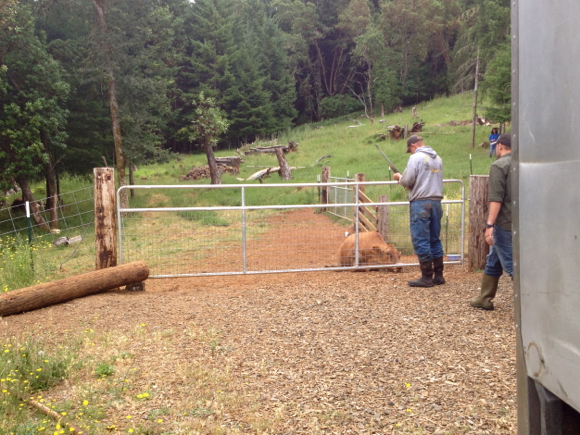
They dragged her over to the truck, turned her over on her back, cut off the hooves, and began skinning her. They only skinned the belly and legs, leaving the skin on the back to act as a protection from the ground. You’ll see that everything they do is so clean and so efficient.
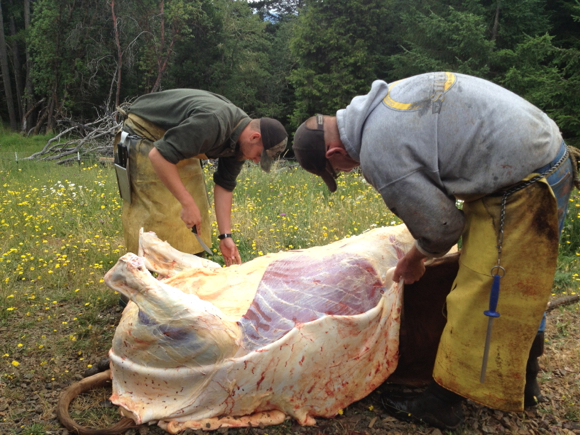
They constantly sharpened their knives. Very nice knives, too. (Victorinox? My husband just got some of those for butchering goats and small game. They’re awesome.)
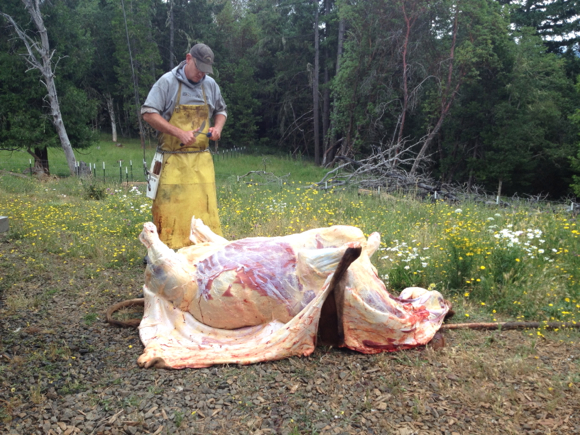
Once the underside skinning was complete, they lifted her up on the hook-deal-winch-thing on the back of the truck. 😉 I think at this point I asked how nicely fatted she was. Josh said she turned out very well, not too lean. That made me happy.

Cleaning, cleaning, always keeping things clean. The truck had water and hose ready to go. Inside the truck, you can see the other beeves processed before ours. Josh said our place was the last stop of the day. They try to do all the mobile slaughtering in the first part of the day while it is still cool.
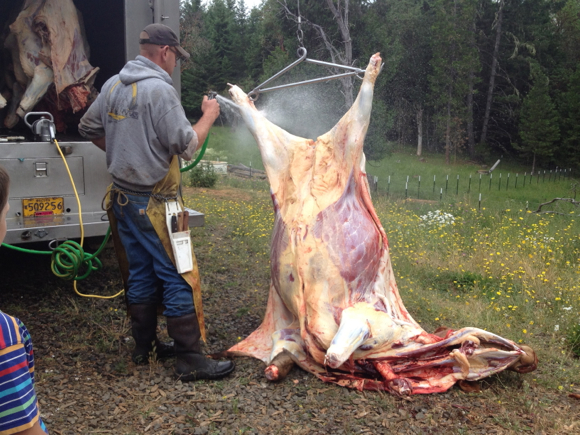
The knives. I took this shot for my husband who could not be present (he was at work and couldn’t get away).
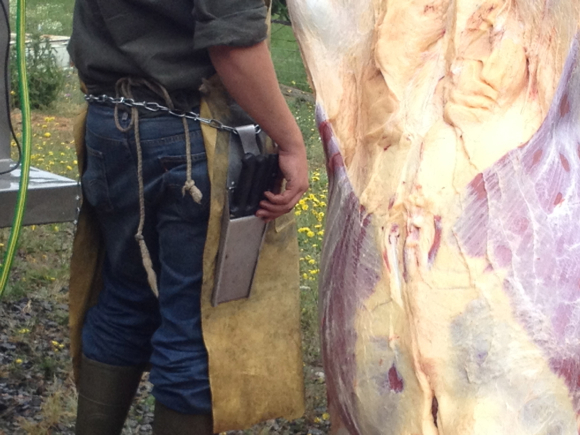
My son C. and his two close friends. They pulled in to visit just when Josh shot Mercy (they heard it in their car). They’ve seen this done before, because they’ve had Oakland Lockers do their slaughtering on several occasions. Still, they were very interested and enjoyed every minute. As boys will!

The girls sat on the fence posts. They look really sad, but they did fine. They were not sad. They thought they would be, but then said it wasn’t so bad. They’ve butchered goats, ducks, and chickens before, and this was much the same though larger scale.


And here’s the kids’ view so you can see what they were seeing.

The boys checking out the tongue. The tail is also in the bowl. The liver and heart will be added soon. This is the bowl of organs I would later take into the house to use or freeze immediately.

She’s entirely lifted up now and they’re gutting her.

Then they finish skinning, and also cut off the head. (We put all the guts, head, hooves, etc. out in the pasture where the chickens and the dog have been munching, chewing, and pecking happily since.)
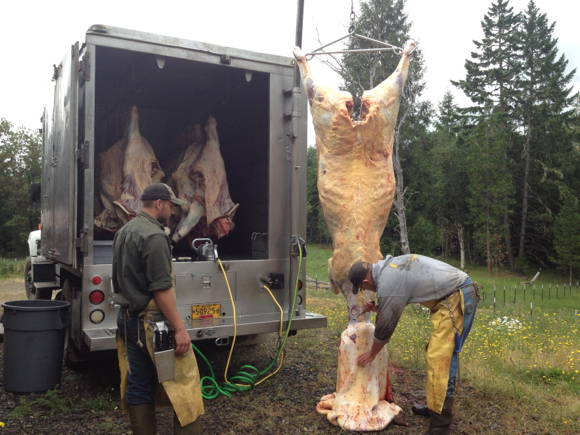
They made incomplete cross-body cuts in the rib area, then sawed her in half completely.

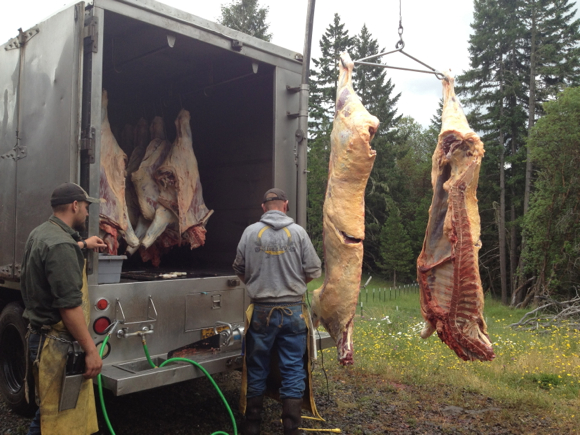
The back of the truck — spic and span. They hosed it off as needed, and hosed their boots off every time they’d get in it. I was really impressed by the cleanliness.
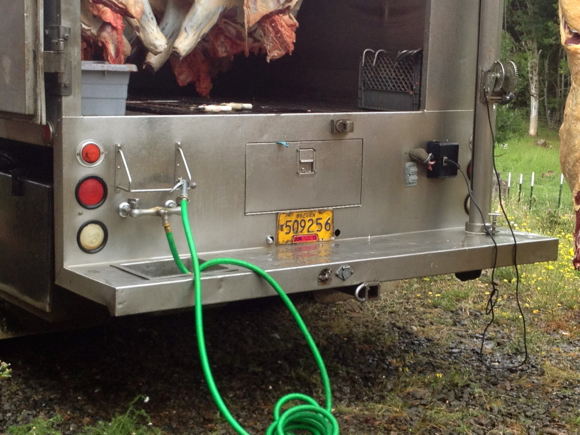
Hosing off the carcass before it went into the truck.

Lifting the halves into the truck.
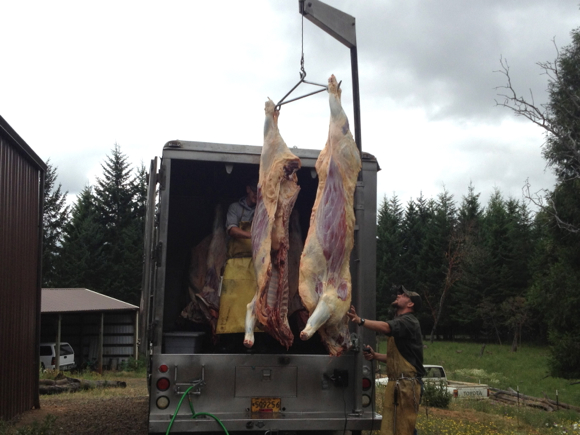
Cutting apart the quarters right in time to slide everything in. Look at the fine kidney fat hanging inside there. I’m keeping that fine fat for sure. On a pig, it is the highest grade of lard, called leaf lard. (Does this mean it is called leaf tallow on a cow?) It is going to chill up at the lockers and they’ll trim it away and package it up for me so I can render it at home.


And closing up the refrigerated truck to head back to the meat locker. The carcass will hang for two weeks, and then cut and wrapped according to our specifications.
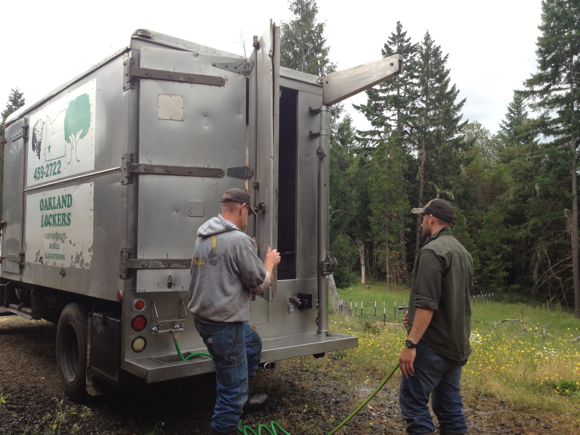
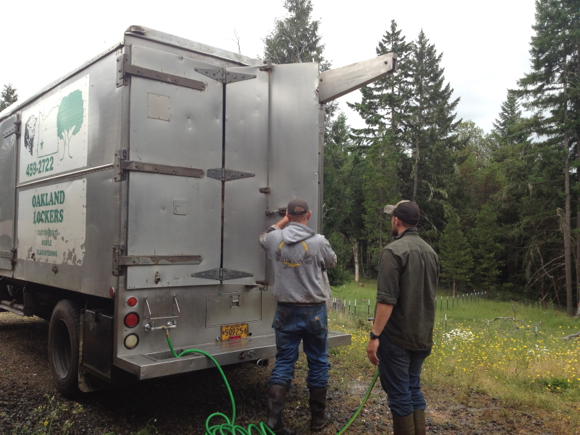
I brought the heart, liver, tongue, and tail inside the house. I was shocked how big the liver was! We ate the heart for dinner Monday and Tuesday. The rest went in the freezer. I cut the liver into five pieces before freezing. We have not had tail before… the other things I know how to fix and we enjoy.

And that was our first beef butchering experience… from the side lines. 🙂
Question for you: Can you recommend any tail recipes? Have you butchered your own beef, or do you hire it out like we did?
We only recommend products and services we wholeheartedly endorse. This post may contain special links through which we earn a small commission if you make a purchase (though your price is the same).


we hire out and they slaughter, then the meat cutter does the rest. How do you fix your tongue and heart……
Oxtail makes wonderful soup!
Do you have a good recipe?
Isn’t there a recipe for oxtail soup in Nourishing Traditions? I am sure I saw it in there, just never had a tail to try it with! 🙂
We love oxtail soup with barley and it’s not really that hard to do. I think I used NT’s recipe. Let us know if you make it!
My grandma makes an amazing oxtail soup, the recipe for which she passed on to me:
Ingredients: 500 gr oxtail (trimmed as much as possible), 1 pig’s trotter (use a clean, new disposable shaving razor to remove any hair – much safer than singeing!) , 1 pig’s ear, filtered cold water to cover, 2 onions (or 1 enormous onion), 2 carrots, 125 gr turnips, 100 gr leeks, 1 tablespoon unrefined salt, 1/2 a cabbage, 400 gr potato, a bunch of dried herbs (any variation of thyme, marjoram, rosemary, sage, etc) and a bay leaf tied together in a muslin cloth (what one could call ‘bouquet garni’ I suppose), a few cloves, 2 cloves of garlic
Chop all vegetables into sizeable chunks. Quarter the cabbage. stud one of the onions with cloves (if using a huge onion, cut it in half, and stud one of the halves with cloves). Place everything except the cabbage into a heavy cast-iron casserole and cover in water. Bring to the boil and skim the foam. Meanwhile, preheat your oven to 120 degrees celcius. Once the foam stops forming, fit a few layers of foil over the casserole; clamp shut with the lid, place in your oven, and cook for 4 hours at least. In the last 1/2 hour, add the cabbage.
Then, pick the meat off the trotter, and the oxtail bones. Cut the ear into strips. Serve in dishes with the vegetables and the hot broth ladled generously over the top. My grandma always served this with some roasted bone marrow and dark rye sourdough bread spiced with coriander and caraway.
Enjoy!
Interesting post Wardee!
We use the tail to make soups and stews. You can use any ox-tail stew or soup recipe for it as well. Our favorite soup is simple: Cut the tail into chunks, brown in some fat, simmer in water with veggies and seasonings ( I use 7-8 allspice berries). Add some tomatoes and cook on low a long time, adding water if needed. When its done, we just pick up the chunks of meat and bone and eat the meat off the bone – that is, any that stays on and isn’t cooked off!
Thank you! I will try that!
Thank you! I will try that!
Thanks for sharing! I went to a butchering class a couple of years ago where my friends brought in one of their Amish friends to show us how to butcher a pig, a sheep and a calf, start to finish, but it’s really neat to see how the mobile butchers do it! We had to take Spot in to the local butcher (about 20 minutes away), but I wasn’t real impressed with how they packaged her, plus once I got the head back (to strip and clean), it looked like they had to take a couple shots with the captive bolt. 🙁 I asked for the organs too, but never did get any of them back. I’ve tried three or four butchers and only found one that I really like, just south of Dallas (which is SUCH a hike to get anything there). I’m going to look into any mobile butchers here in CenTex to see what we’ve got available.
Thanks for sharing! Those organs look wonderful!
We will be hiring a on-site butcher of our first grass-fed beef in the fall. I’m impressed with how clean it looks in your pictures.
Do they label your beef well? I want to make sure we get OUR beef so that we know how well our methods are working.
I have no reason to doubt this butcher. They have an excellent reputation. Having said that, I do not know how they label the meat. 😉 I did ask if we would be sure to get our own beef and they said, “Oh, yes, we make sure of that.”
I hear you there! We and our friends took two hogs, that were almost identical and were full siblings, to the local butcher. We got back one set of pork that was entirely different from the other! We knew which one was our Red Wattle pork, too…guess the butcher decided they needed to keep some of our meat and substitute something else. Same story from a few other folks!
My sis-in-law and bro-in-law do luaus for people 1-3 times per year, and when they used a butcher near the ‘burg (not Oakland Lockers, Wardee), a few years ago, they ordered one variety of pork (a full pig) and saw it before it was butchered, but when they went to pick up their prepared pig so they could put it in the ground for the luau, it was a much smaller pig and a completely different variety! They used Oakland Lockers from that point forward.
Very interesting.
Wow, thanks for sharing that experience! It’s neat when you can watch the whole thing, start to finish. I understand that the kidney fat can be used with ground jerky to make a pemmican that keeps VERY well.
WOW, never seen a cow butchered before. We do our own deer, and it’s actually quite similar. Very clean process by the guys that came out to your place! Thanks for sharing!
That was really interesting and cool! Thanks for sharing!
I cook the tail just like I do my own stew chickens – low and slow in the crock pot, with the usual spices + ACV. Then I use the meat in many different ways along with it’s broth. Most of the ways have been mentioned here 🙂
I have some questions for you – how long from birth to butcher? And how much feed did you supplement her with? I’m wondering if I can buy a calf and raise it up for my next beef bonanza…. Did you vaccinate her or have to do any other medications? And lastly, will you guys be raising up another for next year?
Hugs ?
That dumb ‘?’ I added ascii code for a heart, Oh well you know what I mean *grin*
Interesting and informative post, Wardee. Thank you. Oxtail is good for making broth – nice and boney, and also meaty enough to give the broth a richer flavor.
We normally take our cows to the butcher. We have butchered one ourselves though. I wish we could find a mobile unit. That would be wonderful.
We don’t have any mobile butchers around here, we have to haul them to the butcher’s. Butchering on the farm is so much more humane and I imagine makes for better meat with less adrenaline, well, no adrenaline. I do have one question, how do they mark your beef so you get back your own? I always worry about that, taking in a nice grassfed animal and possibly getting back someones old boner cow…
Sadists.
This is too fabulous. I can’t wait to start raising my own beef and milk.
Wardee, I had a question on the vegetable fermenting blog about how long to ferment. I don’t mean to hijack this blog, but I am kind of desperate for an answer! In your book most kraut ferments say to cool storage them at 7 days on the outside. Other things I’ve read say the ferment needs to go 28 days for most benefit. Can you help me? I don’t want to stop the ferment if I really should be keeping it going for a few more weeks. Thanks!
Thanks for sharing. My almost 5 year old found this fascinating and is asking to see the organ meats in our freezer. We make oxtail soup too. Have never raised our own beef, but hope to someday.
Thanks so much for this post, I’m impressed. I’m considering ordering a 1/4 cow from our food CSA. They list hanging weight. What’s the difference between the hanging weight and the weight I’d get back packaged up? Thanks!
Live weight is when the animal is still alive. After they put them down, they remove the hide, innards, head and the bottoms of the legs. That is hanging weight. Then it hangs and loses some moisture, plus they remove more bones, etc. The weight of the actual meat you get can be up to (not always that much) 35% less than the hanging weight.
Hanging weight varies widely based on how much fat is on the cow. 70% of the weight is a good median for usable meat.
Being South African, we LOVE oxtail stew. This is a link for one of many recipes, if you google ‘South African oxtail recipes’ you’ll find heaps! http://blog.kumkani.com/index.php/2012/04/12/a-great-south-african-oxtail-stew/
I have never cooked liver and the family dont like the idea of it, so I figure if I’m going to do this for the first time and try present it to them, it better be good 😉 Do you have a yummy recipe that I can try on the family?
Thanks for your post! blessings, Annette
One way if the family isn’t very keen on the idea of liver is to mask the taste by putting just a bit of liver into a ground beef recipe or a meatloaf. I like very fresh liver sliced very thin, cooked with a lot of onions.
Great post Wardee! My children enjoyed looking at the pictures. Thanks!
Oxtail works great for Vietnamese style beef noodle soup.
http://www.vietworldkitchen.com/blog/2008/10/pho-beef-noodle-soup.html
I was facinated (and a bit jealous) with this post…Cannot have a cow (that sounds funny) and am not sure where to go in my area (Greenville, SC) to purchase part of a good cow…still doing research, as I’m in my first year of converting, bit by bit to natural foods. Thanks so much for sharing this post…I learned so much and was amazed at the cleanliness and attention to detail that the butchers had!
Heather, try http://www.eatwild.com to find grassfed beef near you.
I told my husband about this and he couldn’t wait to see it! VERY COOL! Thanks so much, Wardee!
Such an interesting post, Wardee. Thanks for sharing! I was worried when I posted about our chicken “processing day” and included warnings so readers wouldn’t be offended by photos they’d rather not see. Your post was tastefully done; I appreciate seeing the process. We don’t raise our own beef (we buy from friends who do), so I don’t have any answers for your questions or recipe suggestions. Enjoy the blessing of a full freezer!
~Lisa
This is a great post, Wardee. It stirred things in me which I had to take time to analyze. This physical reality reminded me of some spiritual truths that I recorded here: http://learningandyearning.com/2012/07/20/nourishment-has-a-cost/.
I’m really impressed, too, that the cow was killed onsite without having to suffer the anxiety of travel. Well done!
We are planning to have 2 cows…a momma and a baby soon…I dont think I could watch them kill the cow in front of me. So we have found someone to come and pick-up the cow and then we go get the meat…it would hurt me to bad to watch it die in front of me…just me i guess
What a blessing to have such a service available. We do our own butchering, it’s a LOT of work!
Someone doesn’t know the meaning of sadist. A shot to the head is very humane and it’s instant. It’s not pleasureable, but you are greatful.
This was interesting…(found you through learningandyearning’s blog) We take our beef to the butcher shop and have it processed there. I’ve often wondered just how they do it, so this was very fascinating to read. I can’t bring myself to eat the heart and tongue (although I did as a young girl) because even though we try not to get attached, it’s almost unavoidable!
Wow, they did it at your place? I didn’t know butchers still did that. So cool!
When I was younger living at home, we butchered our own beef. We waited until about January when we’d have several days in a row of near-freezing weather so it wouldn’t spoil as we worked on getting it cut up and packaged. 🙂
Very interesting we do not have mobile butchers which is too bad as this would make things much easier.
We now do not even butcher as most of our slaughter facilities have been shut down in our area. It is a sad thing.
I am impressed by the way your children handle this our children did too they know of it as a normal part of living and the sacrifice of our loved animals to sustain us.
B
Fascinating post. Thank you for sharing. I was a little surprised to read that your VERY lucky dog got the whole head. It just seemed at odds with your use of the rest of the animal.
This is fascinating. For this city girl, it’s a far cry from what I have seen on television as representative of how animals are traditionally butchered for our national food supply.
That all sounds so awesome…the only thing else I would have kept would have been the cheek meat from the head…love me some barbacoa! Lucky dogs and chickens, I would have fought them for that. The rest my mother in law and some friends would have fought over…but, they know how to cook a lot more Mexican food than I do (stuff that scares me).
We raise grass fed beef but hire local butchers like you do. We would try it ourselves, but we don’t have a cold locker to hang the beef. If there’s enough fat on the meat, you should let it hang for 14 days to get the absolute best flavor. Of course, home raised grass fed beef tastes so much better than the stores. I was raised on a cattle farm and literally cannot cook or eat store bought beef.
Congrats on your first. I know it won’t be your last. 🙂
We raise grass fed beef but hire local butchers like you do. We would try it ourselves, but we don’t have a cold locker to hang the beef. If there’s enough fat on the meat, you should let it hang for 14 days to get the absolute best flavor. Of course, home raised grass fed beef tastes so much better than the stores. I was raised on a cattle farm and literally cannot cook or eat store bought beef.
Congrats on your first. I know it won’t be your last. 🙂
I like your site for all your non-meat information (like fermenting, beans & grains), but am really disgusted with the thought of killing & eating anything that had a mother.
Perhaps this will help you put our carnivorous ways into perspective.
In a study published in the journal Current Biology, Janet Braam, professor and chair of Rice University’s Department of Biochemistry and Cell Biology said in part,
“Vegetables and fruits don’t die the moment they are harvested, They respond to their environment for days.”
i feel you would make more money or profit almost 100 times if that cow was still living !
we have managing 100 thousand cows and no one is killed and still all profit us by using their by product mainly urine and dung to produce more food
Thanks for the information! We take our beef to a family butcher about 45 miles away and it comes back in nice boxes. They cut to our preferences – we like double wrap – shrink plastic and then butcher paper on the outside. We normally keep either a half or a quarter – and sell the rest in either halfs or quarters.
Did you save the cheeks? We just bought 1/2 a steer, and this recipe was DYNAMITE! http://www.recipetineats.com/slow-cooker-red-wine-beef-cheeks/ Now my husband is looking forward to the heart…. what to do?
Oh my lands! You didn’t use the hooves?!! They are a wonderful source of gelatin! (See Sally Fallon’s “Nourishing Broth” book.)
Clean them (wash thoroughly, boil five minutes, then scrub again), stick them in a 7-8 quart CrockPot, add 1/4 cup ACV, fill with about a 1/2 gallon of water, then cook overnight on low. In the morning, strain into pint jars then freeze. Repeat.
You can continue to do this for three to five days – just add more ACV and water. We typically get 10-12 pints out of one set of hooves.
Add a pint to your soups and stews for added richness and flavor.
I have a question, once the meat is packaged and frozen how do you cook the meat so that it does harden when cooked. We butchered one about two weeks ago and packaged some of the meat the rest we cooked and it looked tender until it was served it was sort of hard to chew on. I have tasted some before that was butchered by us but someone else cooked it adn the meat was soo tender. Wanted to know what the secret is? I would ask them but we no longer talk to those people. Please advise.
Hi Melissa,
Especially with grass-fed/pastured animals, choosing the appropriate cooking method is very important because muscle in different locations on an animals cooks up differently. Some meat is full of connective tissue that responds well to slow heat and moisture, while a tender steak would seize up and get tough under the same treatment. Also, if the meat is from an older animal (sometimes called a cull) these tend to be tougher, you may not have steaks from these but roasts and ground is very common. Low and slow works well for roasts.
We have a lesson in our Fundamentals II eCourse: https://traditionalcookingschool.com/lp/member/ or eBook: https://traditionalcookingschool.com/lp/ebook-fundamentals/
All about pastured meats which includes information on the various cuts and how each is best prepared.
Grassfed Gourmet, http://amzn.to/1MqUVdB, is also an excellent resource.
Hope this helps!
~ Millie, TCS Customer Success Team
Thank you for documenting your entire process for butchering beef. Love seeing the process from A to Z and learning along the way!
Do you have fat added into your ground meat? If so, what kind of fat is used?
Hi, Christina,
Some of our team members have added bacon grease, olive oil, or butter to theirs depending on the recipe.
~Peggy, TCS Customer Success Team